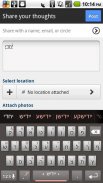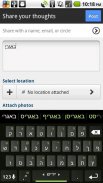




Yiddish Keyboard Plugin

Descrição do Yiddish Keyboard Plugin
Yiddish Dictionary plugin for Multiling O Keyboard autocorrect and word prediction
Instruction:
⑴ Install this plugin and Multiling O Keyboard. https://play.google.com/store/apps/details?id=kl.ime.oh
⑵ Run O Keyboard and follow its setup guide.
⑶ Slide space bar to switch languages.
If you have font issue, read this: <a href="https://www.google.com/url?q=https://www.google.com/url?q%3Dhttp://honsoapps.appspot.com/1/ma.html%26sa%3DD%26usg%3DAFQjCNG71Nl5i6QMcdEZvU1BqM2L70OWlQ&sa=D&usg=AFQjCNHJAfktVVilzCrduIwvK96EQvYRGw" target="_blank">http://honsoapps.appspot.com/1/ma.html</a>
Wikipedia:
Yiddish (ייִדיש, יידיש or אידיש, yidish/idish, literally "Jewish") is the historical language of the Ashkenazi Jews. It originated during the 9th century in Central Europe, providing the pre-existing language of the nascent Ashkenazi community with an extensive Germanic based vocabulary. Yiddish is written with a fully vocalized alphabet based on the Hebrew script.
The earliest surviving references date from the 12th century and call the language לשון־אַשכּנז (loshn-ashknez = "language of Ashkenaz") or טײַטש (taytsh), a variant of tiutsch, the contemporary name for Middle High German. In common usage, the language is called מאַמע־לשון (mame-loshn, literally "mother tongue"), distinguishing it from Hebrew and Aramaic, which are collectively termed לשון־קודש (loshn-koydesh, "holy tongue"). The term "Yiddish" did not become the most frequently used designation in the literature until the 18th century. In the late 19th and into the 20th century the language was more commonly called "Jewish", especially in non-Jewish contexts, but "Yiddish" is again the more common designation.
Modern Yiddish has two major forms. Eastern Yiddish is far more common today. It includes Southeastern (Ukrainian–Romanian), Mideastern (Polish–Galician–Eastern Hungarian), and Northeastern (Lithuanian–Belarusian) dialects. Eastern Yiddish differs from Western both by its far greater size and by the extensive inclusion of words of Slavic origin. Western Yiddish is divided into Southwestern (Swiss–Alsatian–Southern German), Midwestern (Central German), and Northwestern (Netherlandic–Northern German) dialects. Yiddish is used in a large number of Orthodox Jewish communities worldwide and is the first language of the home, school, and in many social settings among most Hasids. Yiddish is also the academic language of the study of the Talmud according to the tradition of the Lithuanian yeshivas.
The term Yiddish is also used in the adjectival sense, synonymously with Jewish, to designate attributes of Ashkenazi culture (for example, Yiddish cooking and Yiddish music).[4]
</div> <div jsname="WJz9Hc" style="display:none">Yiddish plug-in Dicionário MultiLing O autocorrect Teclado e previsão de palavras
Instrução:
⑴ Instale este plugin e MultiLing O Teclado. https://play.google.com/store/apps/details?id=kl.ime.oh
⑵ Run O Teclado e seguir o seu guia de configuração.
⑶ barra de espaço Deslize para alternar os idiomas.
Se você tem problema de fonte, leia isto: <a href="https://www.google.com/url?q=http://honsoapps.appspot.com/1/ma.html&sa=D&usg=AFQjCNG71Nl5i6QMcdEZvU1BqM2L70OWlQ" target="_blank">http://honsoapps.appspot.com/1/ma.html</a>
Wikipedia:
Yiddish (ייִדיש, יידיש ou אידיש, Yidish / idish, literalmente "judaico") é a linguagem histórica dos judeus Ashkenazi. Originou-se durante o século 9 na Europa Central, fornecendo a língua pré-existente da comunidade Ashkenazi nascente com um extenso vocabulário com base germânica. Yiddish é escrito com um alfabeto totalmente vocalizado com base no roteiro hebreu.
As primeiras referências sobreviventes datam do século 12 e chamar a linguagem לשון-אַשכּנז (loshn-ashknez = "linguagem de Ashkenaz") ou טייַטש (taytsh), uma variante do tiutsch, o nome contemporâneo para alemão médio-alto. No uso comum, a língua é chamado מאַמע-לשון (mame-loshn, literalmente "língua materna"), distinguindo-a de hebraico e aramaico, que são denominados coletivamente לשון-קודש (loshn-koydesh, "língua sagrada"). O termo "Yiddish" não se tornou a designação mais frequentemente utilizado na literatura até o século 18. No final dos anos 19 e no século 20 foi a língua mais comumente chamado de "judeu", especialmente em contextos não-judeus, mas "Yiddish" é novamente a designação mais comum.
Iídiche moderno tem duas formas principais. Eastern Yiddish é muito mais comum hoje. Ele inclui Sudeste (ucraniano-romeno), Mideastern (polonês-galego-Eastern húngaro) e Nordeste (lituano-bielorrussa) dialetos. Eastern Yiddish difere da Western tanto pelo seu tamanho muito maior e pela ampla inclusão de palavras de origem eslava. Yiddish ocidental é dividido em Texmex (Swiss-Alsácia-sul alemão), Centro-Oeste (Central alemão), e Northwestern dialetos (Netherlandic-Northern alemão). Yiddish é usado em um grande número de comunidades judaicas ortodoxos em todo o mundo e é a primeira língua da casa, na escola, e em muitos ajustes sociais entre a maioria dos Hasids. Yiddish é também a linguagem acadêmica do estudo do Talmud de acordo com a tradição da yeshivas lituano.
O termo iídiche também é usado no sentido adjetiva, como sinônimo de judeu, para designar atributos da cultura Ashkenazi (por exemplo, culinária e música iídiche iídiche). [4]</div> <div class="show-more-end">

























